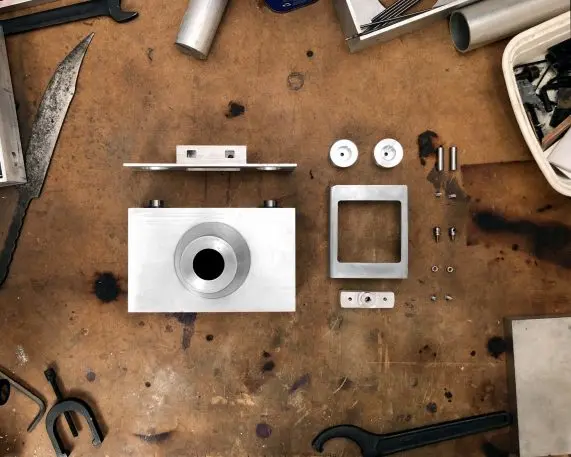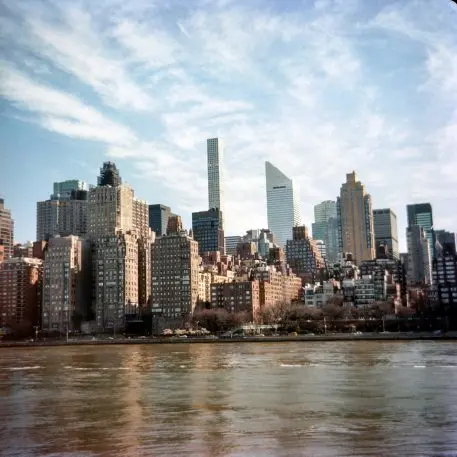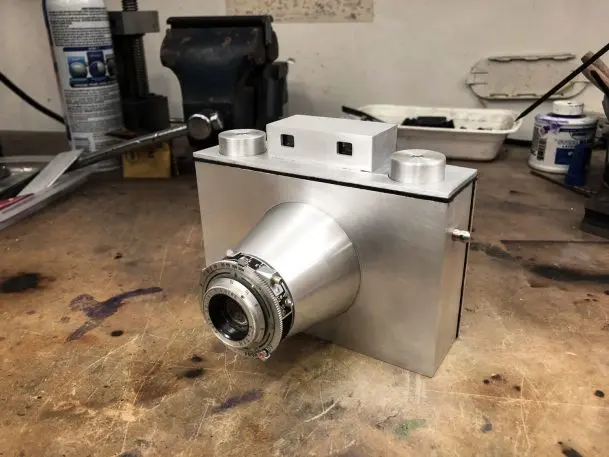When applying to college in 2009, photographer and DIY camera maker Lucus Landers threw himself a curveball. Initially he planned to study mechanical engineering, but the technical side of photography appealed to him, so he decided to apply to a single art school, on one condition: If accepted, he had to go. He Googled “best photography school,” and the top search result was Pratt Institute. Despite knowing next to nothing about art, Landers was accepted and headed to Brooklyn to train as a photographer and artist.
After focusing on photography’s aesthetic side for two years, Landers decided to build his own camera, to satisfy both a creative impulse and a desire to design and build something. But it was also a case of necessity being the mother of invention. For a university course, Landers built a large-format 4-by-5-inch camera, as it was far cheaper than buying one. He now finds himself on his eighth camera build, the Landers AL6 Mark II, an all-aluminum medium-format camera that is light, durable, and a serious image-capturing machine.

As with Mo’s DM Flex, it’s no hyperbole to say that the AL6 Mark II’s photographs are as handsome as its construction. Minimalist in design and aesthetics compared with modern manual cameras, Landers tells Fast Company that this camera builds upon its predecessors’ technical and aesthetic foundations. Whereas his first model, the Landers Large Format, had to be fixed to a tripod and operated like a vintage wet-plate camera, thus severely limiting its portability, Landers can take the lightweight AL6 Mark II anywhere, and just point and shoot.
[Animation: courtesy of Lucus Landers]The AL6 Mark II also differs markedly from Landers’s beautiful wood-and-metal-framed Instant Press Camera, a mobile instant analogue camera that is now retired after Fuji ended production of its Intax film, making it cost-prohibitive to use. The AL6 Mark II marks his second foray into the medium-film format (larger than 24 x 36 mm, but smaller than 4-by-5-inch photographs); the first being the Landers B66, an all-bronze camera that he soldered together and outfitted with a vintage Agfa 85mm lens. The AL6 Mark II has Landers’s aluminum camera body, making it lightweight and durable.
The first AL6 Mark II camera part Landers made was the nose cone, which holds the lens. First, he 3D-printed a pattern, which he used to create a sand mold in which he cast the aluminum. Landers then milled the nose cone to get a precision cut, before turning his attention to the camera body. After welding the sides together and machine squaring it, he cut a hole in the body, then bonded it to the nose cone by heating the two components with a MAP gas torch and a press. Landers made the top cap, which holds the rangefinder and other controls, by casting aluminum once again in a sand mold, then milling it down to size.
“Aluminum is cheap and very good to build with,” says Landers. “The downside is that aluminum is not seen as a very desirable material from an aesthetic perspective.”
Using a lathe to rotate the entire camera, Landers gently brushed the Mark II body and nose cone simultaneously to get a continuous brush pattern. The AL6 Mark II’s internals build off the B66 template, from the body down to the recycled Agfa 85mm lens that comes with an aperture and shutter.
“Right now, the Agfa 85mm lens is a surprisingly sharp lens if you know how to use it,” Landers explains. “At about F8 or F11 is where you get the sharpest image.”

A surprisingly difficult step in the design and build process is getting the film plane properly calibrated. It must be as perpendicular as possible to the lens mount and a very exact distance away, with the film lying perfectly against it. If any of these variables are off even the slightest bit, the image will blur. Made of aluminum, the film plane is a flat piece with a square opening and two sides welded onto it. Landers milled it completely flat, then tack-welded it inside the camera body at an exact height (78.2 mm from the surface). To keep pressure on the film, he fashioned a spring-loaded pressure plate and welded it to the back of the camera body. To hold the back door closed, Landers fixed magnets to the camera body, then painted the inside black and lined it with felt.
[Animation: courtesy of Lucus Landers]After final assembly, Landers loaded a test roll into the camera to see how it operated. The first image, a high-resolution photo of his milling machine, was captured by placing the camera on a tripod, setting the aperture to f32, and exposing it for eight seconds. While most of the image is high resolution, there is quite a bit of blur at the corners. In a photograph of a plastic bag hanging from a tree branch, Landers shows off the AL6 Mark II’s depth of field. The plastic bag and tree branch are in focus, but the background is blurred. To capture these details, he shot at 1/30th to 1/60th of a second, with an aperture of about f5.6. Landers was also able to put backgrounds into focus while blurring out objects and surfaces in the foreground.
“It thrives as a go-anywhere, do anything camera,” says Landers. “So when I shoot with this camera, I’m going to strap this on my back and photograph the things I see that day.”

But a DIY 35 mm is no easy task. These cameras are far more complex than medium-format models, so designing one is forcing Landers to learn more about camera design. Getting the frame advancement right, as he notes, is a complex feat of engineering.

Landers has been studying work by clockmakers and watchmakers to get this geared mechanism right. Another goal is make his own shutter to truly control his camera’s image. But with 50 to 100 moving parts, the shutter design is also demanding a great deal of research. Ultimately, Landers wants to build a camera that lasts, if not forever, then a very long time indeed, like the Leica M6.
“I want to achieve the same quality of a Leica and then surpass it in my own way,” he adds. “Every camera I make is taking me one step closer to that goal.”
Recognize your brand’s excellence by applying to this year’s Brands That Matter Awards before the early-rate deadline, May 3.